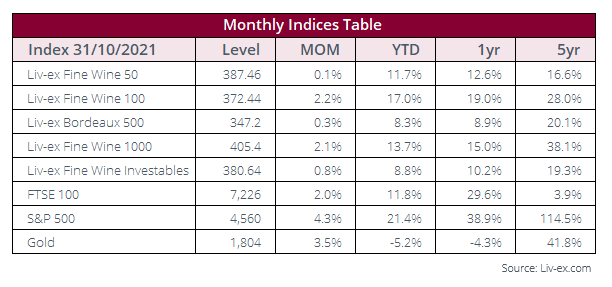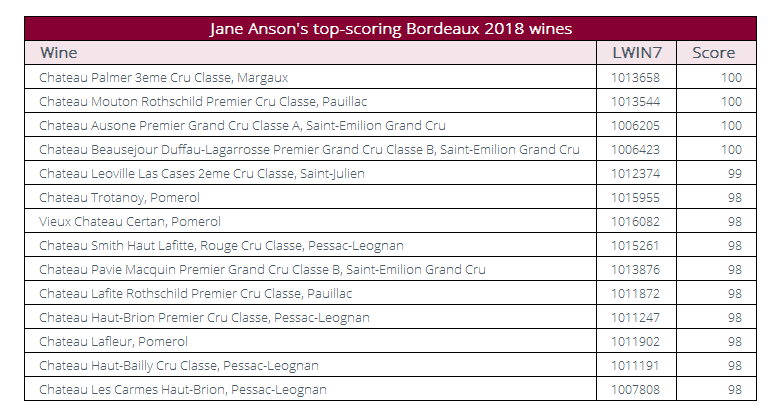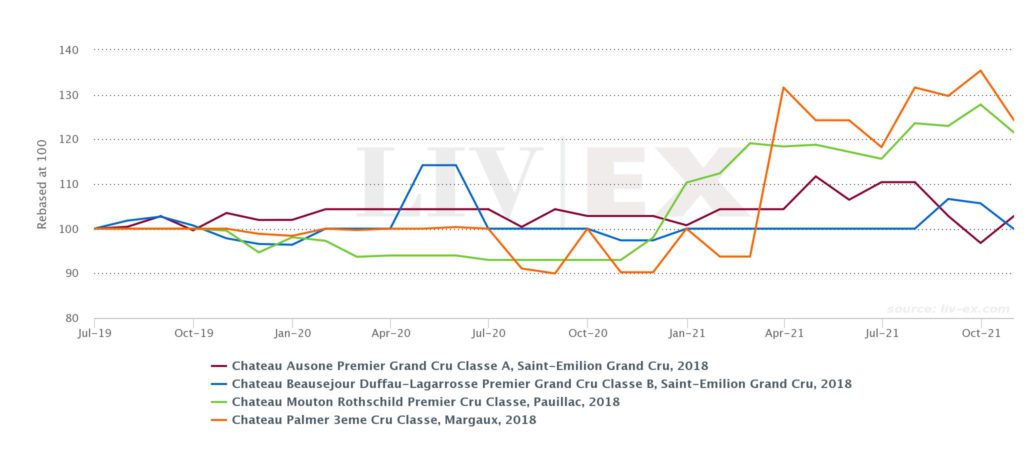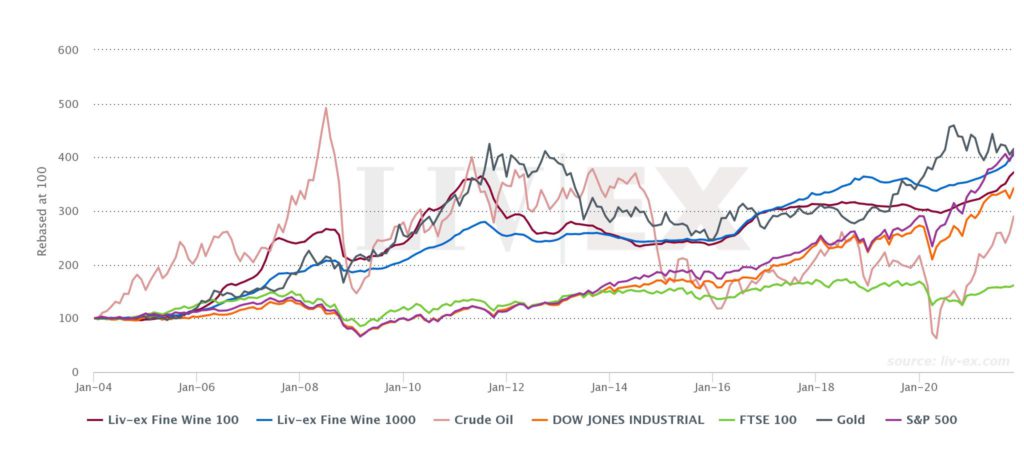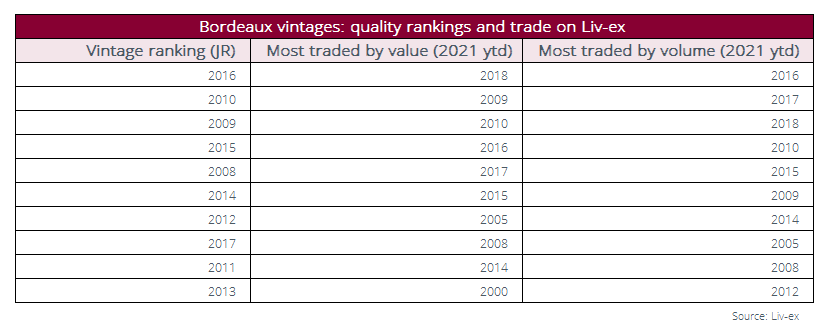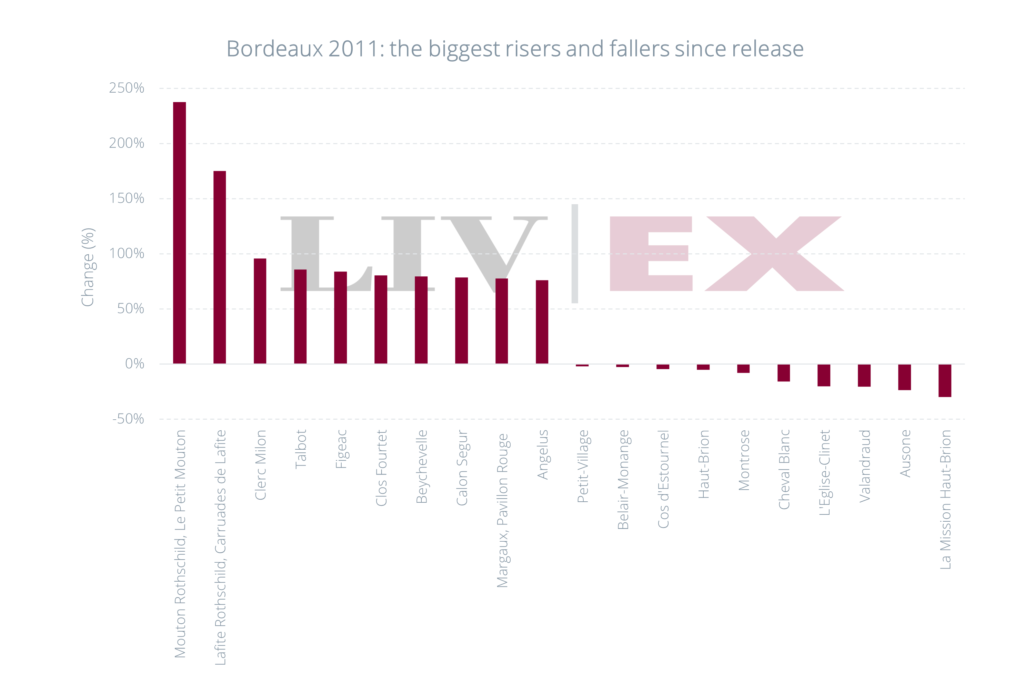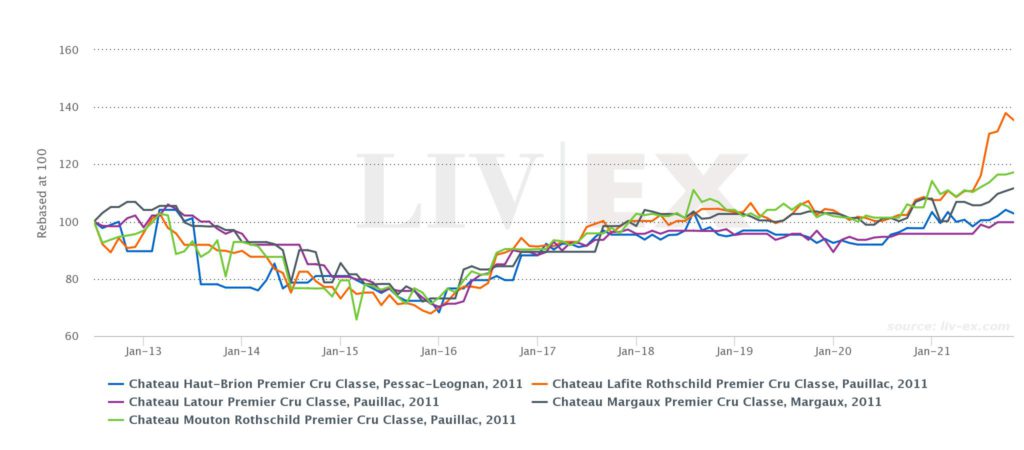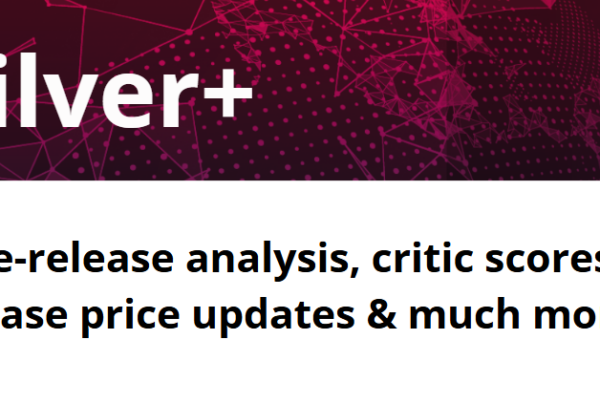Print and read offline instead.
Fine wine market surpasses decade-old record
Fine wine prices rose to new highs and trading activity continued to build as the bullish market sentiment continued through October. The wine market’s benchmark, the Liv-ex Fine Wine 100, rose 2.2%, driven by strong demand for Burgundy’s top domains. The index has risen steadily over the past 17 months, marking its longest upward trend since its creation 20 years ago.
The broadest measure, Liv-ex 1000, set another record in October, up 2.1%, its eleventh consecutive month of gains. The Champagne 50 sub-index rose 7.6% fuelled by demand for the 2008 vintage, in particular the release of Krug 2008. The Bordeaux Legends 40 and the Bordeaux 500 were the slowest movers, up just 0.3%. Prices for the First Growths flat with a rise of just 0.1% in October.
Trade by value was led by Pétrus, while Châteauneuf-du-Pape’s Domaine de la Janasse led trade by volume.
By the end of October, the number of wines traded on the market had surpassed last year’s full year (record) number climbing to 10,798 (as measured by LWIN11s – wine and vintage). The diversity of trade was also reflected in the market share numbers.
Champagne took an 8.7% share of the market by value, after the release of Krug 2008 triggered strong secondary market activity across various Champagne houses. The Rhône had a strong month too, accounting for 5.1% of trade by value. Piedmont (7.1%) led Italian trade, while Tuscany took a smaller part of the market (6.3%). Burgundy accounted for 21.2% of trade by value, while Bordeaux dipped from September’s 36.9% to 35.6% in October. Its most traded vintages were 2009, 2010 and 2018.
Jane Anson awards four Bordeaux 2018 wines 100 points
Bordeaux wine critic Jane Anson officially launched her independent website last month. Her launch report focused on the top 100 Bordeaux 2018 wines. It included rankings of the top 50 to lay down, top 30 to drink now and the top 20 whites. Her favourite wines with a score of 98-points or more can be found in the table above.
Across the board, four wines received the perfect 100-point score – Château Palmer, Château Mouton-Rothschild, Château Ausone and Château Beauséjour Duffau-Lagarrosse. The former two have risen significantly since release.
*made with the Liv-ex charting tool
Anson called the 2018 Palmer ‘a standout success’ despite an ‘extremely stressful growing season’. Its price has risen 24% since release, and currently stands at £3,579 per 12×75.
Regarding Mouton, Anson commented: ‘I’m not alone in considering this one of the all-time great Moutons’ and described it as a ‘powerhouse of beautiful fruits’. The 2018 Mouton has also appreciated by 21.5% in value since release and is available for £6,076 per 12×75.
Ausone, which displays both ‘tension and precision,’ according to Anson, has also moved upwards albeit a smaller 2.8%, to now cost £6,800 per 12×75.
The most affordable of Anson’s perfect scorers, Beausejour Duffau-Lagarrosse has kept its value since release and is available for £1,111 per 12×75. According to Anson, it is, ‘impossible to leave out of my top 50 for laying down because this is easily one of the wines of the vintage and should form part of any cellar that is looking to reflect the best of 2018’.
Her full Bordeaux 2018 report, including more technical information about the wines, is available to subscribers to her website. Anson is expected to publish her Bordeaux 2019 in-bottle assessment later this month.
Burgundy prices soar on the lack of supply
Prices for high-end Burgundy wines are rising once again. With a low-yielding 2021 vintage in the pipe, and a trend toward reduced allocations, prices for vintages available on the market are on the up.
The Burgundy constituents of the Liv-ex 100 and the Liv-ex 1000 drove the indices higher in October. The majority of top performers from the region come from the relatively scarce 2015 and 2016 vintages. Armand Rousseau’s 2015 Chambertin led the way with a 12.5% rise. The wine was among Neal Martin’s highest-scored Burgundy 2015 wines at the annual Burgfest tasting in 2018, awarded 98-points.
Leflaive’s Chevalier Montrachet 2016 was also on the move, where ‘the yield was not much more than 10 hectolitres per hectare,’ according to Stephen Tanzer’s tasting note. The wine boasts 93-95 points from the critic.
Burgundy tops the regional charts based on the number of wines trading on the secondary market. Year-to-date, its share of trade by value stands at 20.7%, more than last year (17.9%) while also breaking its record share of 19.6% in 2019.
New Q3 review and the revamped charting tool
*made using the Liv-ex charting tool
Liv-ex published its first ‘Quarterly Review’ this October. Looking back at the third quarter of the year (July-September), it covered the on-going momentum of the fine wine secondary market, as well as the best-performing indices and wine labels.
As can be seen in the chart above, the bullish performance of the Liv-ex 100 and Liv-ex 1000 indices over the past year has kept them ahead of several leading equities including the FTSE100 and Dow Jones.
(Liv-ex launched its re-vamped Charting Tool in late September allowing members to compare individual wines by vintage regional indices, and mainstream financial assets).
UK alcohol tax overhaul, new ‘La La’ and St-Emilion classification case ends
The UK’s Chancellor of the Exchequer, Rishi Sunak, unveiled the autumn budget in late October. This included a wholesale overhaul of the alcohol tax system. From February 2023 drinks will be taxed according to their alcohol volume not by type as was the case before. Although tax will be frozen until this point, it will lead to price increases for the majority of table wines and greater complexity for the trade. Lovers of Champagne, however, will benefit from reduced duty.
The long-running legal battle over the 2012 St-Emilion classification has come to an end. A Bordeaux tribunal fined Château Angélus’s owner, Hubert de Boüard, €40,000 for his part in the case, ruling that he had wielded undue influence in promoting estates he was personally involved with. Co-defendant Philippe Casteja, owner of Château Trottevieille, was acquitted.
Rhône producer E. Guigal has announced that there will soon be a fourth ‘La La’. The estate’s single vineyard Côte Rôties: La Turque, La Mouline and La Landonne, will be joined by ‘La Reynarde’ – named after the stream that separates the Côte Brune and Côte Blonde. The vineyard for the La Reynarde was prepared in 2010 and the first vines planted in 2015. The estate has said it is waiting for a ‘great’ vintage before bottling the first wine.
Auction house Sotheby’s held two large sales at the end of October. The first featured ex-cellar wines from House of Chanel’s properties Château Canon and Château Rauzan-Ségla. The top-selling lot was a whole barrel of 2020 Canon, which was sold for £40,000. The auctioneer also held its first sale in France, featuring a private collection of Domaine de la Romanée-Conti, that made €1.3m in total.
Bordeaux 2011 reappraised 10 years on
One of Bordeaux’s most challenging vintages of the past 20 years recently drew renewed attention, as trade and critics went back to reassess the 2011 wines 10 years on. How have the wines evolved stylistically and how have they performed on the secondary market?
Vintage overview from growing season to market
2011 was a difficult growing season in Bordeaux, characterised by a hot and dry spring, cool summer, hail in early September and an onslaught of botrytis. The 2011s followed on from two vintages – the 2009 and 2010 – hailed as excellent by all, and that were released at record prices at the peak of the Bordeaux market.
By the time the 2011s were released En Primeur in summer 2012, the fine wine market was in steep decline having peaked in July 2011. Bordeaux prices had slumped 17.5% from this former high and despite generally lower pricing, the 2011s failed to stimulate market demand.
Ten years later, critics have revisited the vintage. Jancis Robinson MW, who was first to publish her tasting report, revealed that opinion among critics had not changed drastically. The panel who blind-tasted the wines ranked the reds only above the 2013s in quality (since 2009), as can be seen in the table below. As in 2017, the cooler growing season led to less ripe reds but proved a boon for the sweet whites, many of which received high critic scores this October.
Over the past decade, the 2011s have also found their place on the secondary market. Since release, they have become the sixth most traded Bordeaux vintage by volume and ninth by value. So far in 2021, however, they have been outshone by more recent ‘on’ and ‘off’ vintages.
Robinson’s top-scoring Bordeaux 2011s can be found in this article. Neal Martin (Vinous) is expected to release his vintage report later this month.
Best and worst price performers
Although the 2011s never led market demand, the vintage has given rise to a number of impressive price performers. From the 88 leading estates that Liv-ex follows annually during En Primeur, 69 have risen in value; some by triple figures such as the second wines of Mouton and Lafite Rothschild. Two have kept to their release level, and 16 have fallen between 1% and 30%. The top 10 biggest risers and fallers can be seen in the chart below.
The First Growths’ performance
Apart from Latour which was Robinson’s highest-scoring wine of the vintage, all of the 2011 First Growths have risen in value since release. The 2011 was the last En Primeur offering from Château Latour, which opted out of the system after the campaign. The wine currently sits 0.2% below its release price.
The best performer has been Lafite Rothschild, up 35.4%, followed by Mouton Rothschild (17.2%), Margaux (11.7%) and Haut Brion (2.8%).
*made using the Liv-ex charting tool
Overall, Bordeaux 2011 has gone down in history as a difficult vintage to make and sell. Although it has often been regarded as a less investable vintage, many wines have seen steady price returns, and their entry point remains lower than several peers. Now that fine wine prices are on the rise and the spotlight is back on the 2011s, will the market be able to regard the vintage in a new light?
Liv-ex analysis is drawn from the world’s most comprehensive database of fine wine prices. The data reflects the real time activity of Liv-ex’s 530+ merchant members from across the globe. Together they represent the largest pool of liquidity in the world – currently £80m of bids and offers across 16,000 wines. Independent data, direct from the market.


